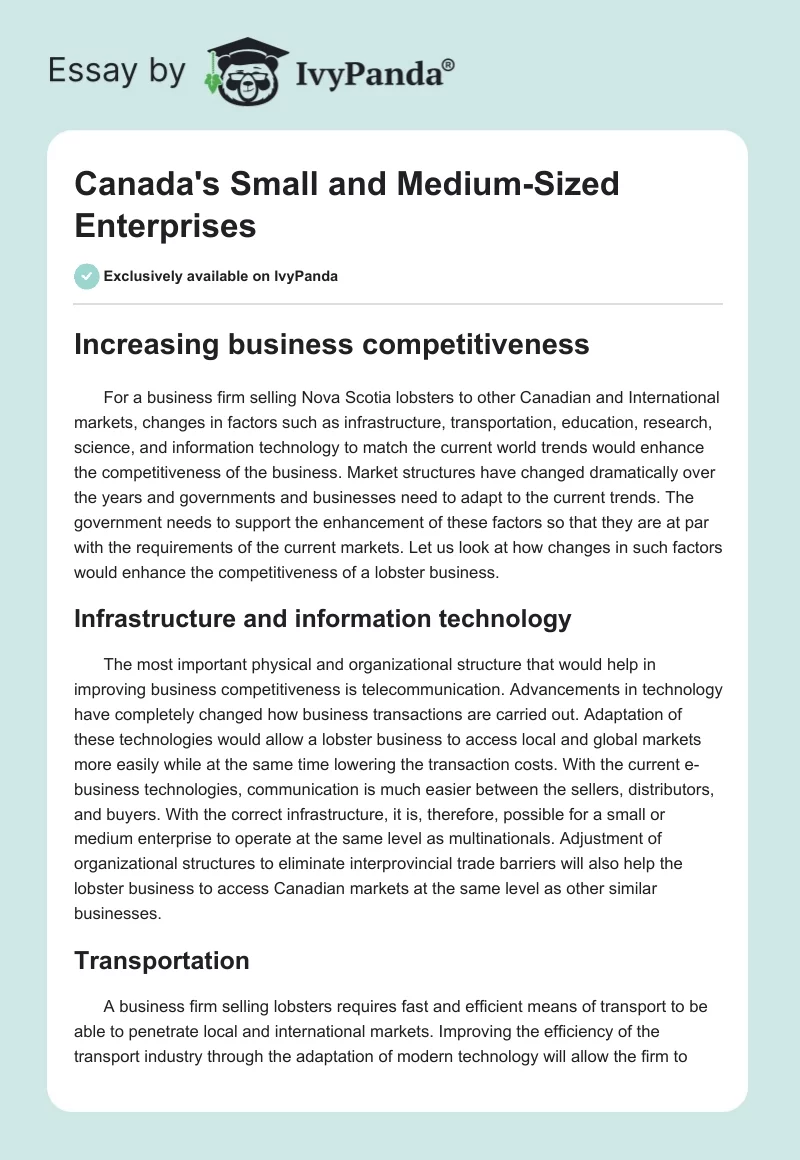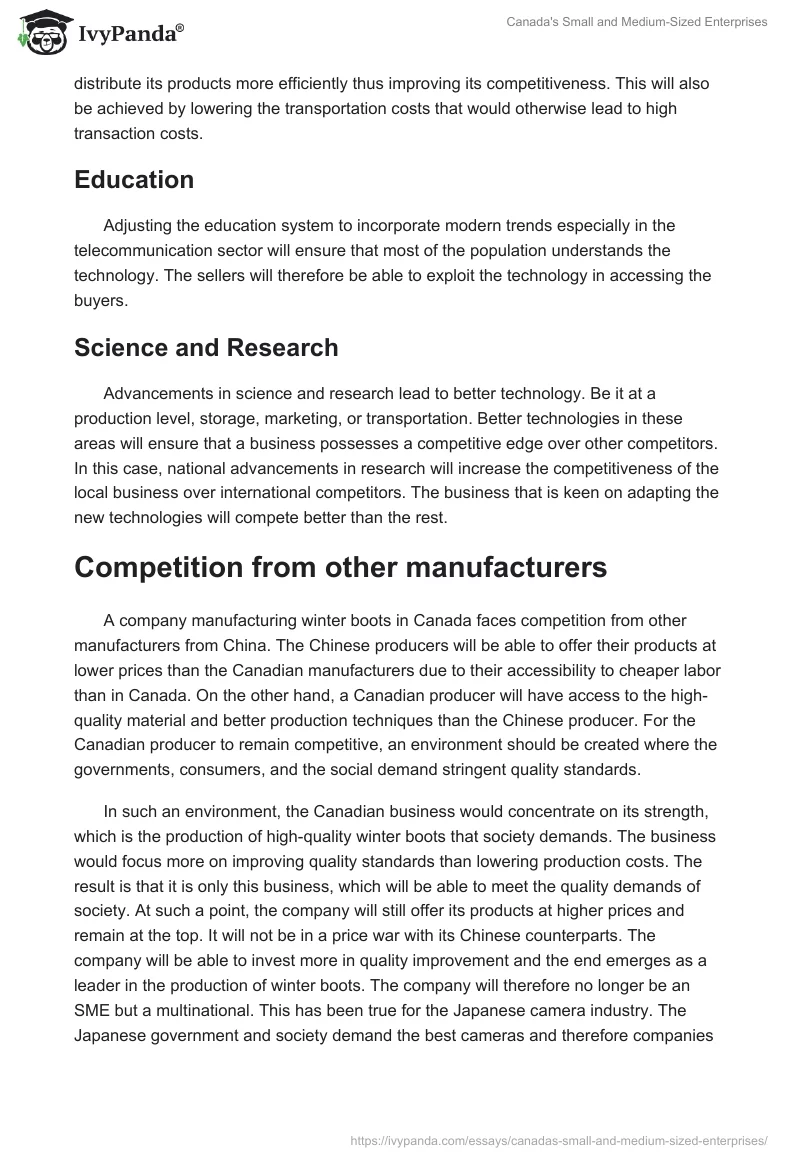Increasing business competitiveness
For a business firm selling Nova Scotia lobsters to other Canadian and International markets, changes in factors such as infrastructure, transportation, education, research, science, and information technology to match the current world trends would enhance the competitiveness of the business. Market structures have changed dramatically over the years and governments and businesses need to adapt to the current trends. The government needs to support the enhancement of these factors so that they are at par with the requirements of the current markets. Let us look at how changes in such factors would enhance the competitiveness of a lobster business.
Infrastructure and information technology
The most important physical and organizational structure that would help in improving business competitiveness is telecommunication. Advancements in technology have completely changed how business transactions are carried out. Adaptation of these technologies would allow a lobster business to access local and global markets more easily while at the same time lowering the transaction costs. With the current e-business technologies, communication is much easier between the sellers, distributors, and buyers. With the correct infrastructure, it is, therefore, possible for a small or medium enterprise to operate at the same level as multinationals. Adjustment of organizational structures to eliminate interprovincial trade barriers will also help the lobster business to access Canadian markets at the same level as other similar businesses.
Transportation
A business firm selling lobsters requires fast and efficient means of transport to be able to penetrate local and international markets. Improving the efficiency of the transport industry through the adaptation of modern technology will allow the firm to distribute its products more efficiently thus improving its competitiveness. This will also be achieved by lowering the transportation costs that would otherwise lead to high transaction costs.
Education
Adjusting the education system to incorporate modern trends especially in the telecommunication sector will ensure that most of the population understands the technology. The sellers will therefore be able to exploit the technology in accessing the buyers.
Science and Research
Advancements in science and research lead to better technology. Be it at a production level, storage, marketing, or transportation. Better technologies in these areas will ensure that a business possesses a competitive edge over other competitors. In this case, national advancements in research will increase the competitiveness of the local business over international competitors. The business that is keen on adapting the new technologies will compete better than the rest.
Competition from other manufacturers
A company manufacturing winter boots in Canada faces competition from other manufacturers from China. The Chinese producers will be able to offer their products at lower prices than the Canadian manufacturers due to their accessibility to cheaper labor than in Canada. On the other hand, a Canadian producer will have access to the high-quality material and better production techniques than the Chinese producer. For the Canadian producer to remain competitive, an environment should be created where the governments, consumers, and the social demand stringent quality standards.
In such an environment, the Canadian business would concentrate on its strength, which is the production of high-quality winter boots that society demands. The business would focus more on improving quality standards than lowering production costs. The result is that it is only this business, which will be able to meet the quality demands of society. At such a point, the company will still offer its products at higher prices and remain at the top. It will not be in a price war with its Chinese counterparts. The company will be able to invest more in quality improvement and the end emerges as a leader in the production of winter boots. The company will therefore no longer be an SME but a multinational. This has been true for the Japanese camera industry. The Japanese government and society demand the best cameras and therefore companies like Kodak focus more on quality improvement and have emerged as the best in the industry. Every consumer ends up desiring to enjoy his or her quality.
Protectionism
Protectionism is common in the Canadian softwood lumber industry. Provinces have put up barriers to protect their producers from competition. Producers from other provinces are unable to penetrate the markets available in other provinces. Such barriers include higher taxes, unreasonable quality standards, transportation barriers, to name but a few. From estimations, interprovincial trade barriers in general cause Canada to waste billions of dollars in national competitiveness. Elimination of such barriers would therefore be beneficial to the entire Canadian industry in terms of achieving more national competitiveness.
For the Canadian softwood lumber industry, elimination of these trade barriers would mean that the costs initially incurred by the producers to sell their produce in other provinces are eliminated. The funds will be used in the improvement of other operations that will enable the firms to push ahead in international competition. Locally, the firms would be able to compete at the same level and this kind of competition makes the firms more innovative to remain ahead of the other competitors in the business. Providing firms with equal opportunities lead to an innovative competition where the firms set up innovative marketing strategies and improve product quality to retain their market share. Such competition creates a need for market expansion to other countries. By accessing the nationwide market easily, the firms would generate enough funds to be able to venture internationally.
Elimination of such barriers would also attract other investors who might have initially shied away from the industry. Soon the market would be saturated with all these businesses and international ventures would be desired. However, for the elimination of these barriers to benefit the entire lumber industry, unfair trade practices by the well-established firms must be prevented.
Confidence
One way in which the government can create national competitiveness is through “encouraging and enhancing sustained investment through a tax rate for long-term capital gains to support new investments in corporate equity” (“Topic 409”, para.1). Capital gains are the profits made on investments in capital assets like stocks, bonds, and real estates Long-term capital gains are the gains made after an asset has been held for more than a year. Tax rates on long-term capital gains are usually lower than on short-term capital gains to encourage investments (“Topic 409,” para.3).
This means that a lower tax rate is used on profit made from long-term investments in stocks or shares of the local enterprises. Investors would therefore be encouraged to make long-term investments in the stocks of the corporate enterprises to benefit from the lower tax rates. After benefiting from these lower tax rates, they will naturally use the funds that were not deducted to make new investments in corporate equities. It is just like when the income tax is reduced, people increase their level of spending. Through these sustained investments, SMEs will be able to acquire the capital required to expand their operations.
Work cited
“Topic 409: Capital Gains and Losses.” Tax topics. International Revenue Service. 2009. Web.


